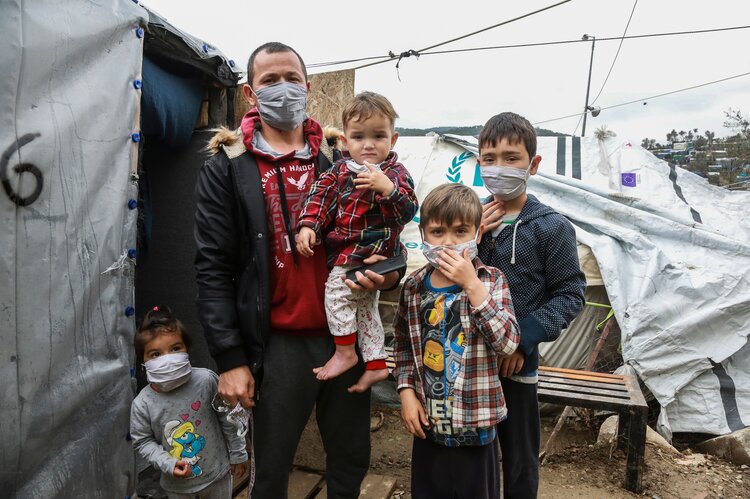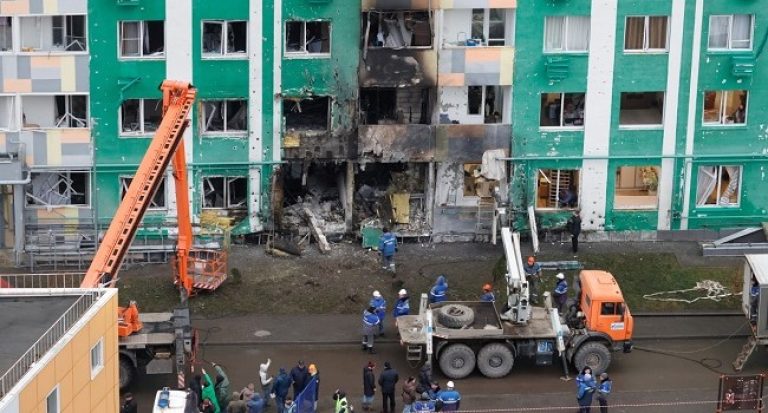
A migrant family wearing handmade protective face masks stand next to their tent in the camp of Moria in the island of Lesbos on March 28, 2020 as as the country is under lockdown to stop the spread of Covid-19 disease caused by the novel coronavirus. (Photo by Manolis LAGOUTARIS / AFP) (Photo by MANOLIS LAGOUTARIS/AFP via Getty Images)
In a camp at the U.S.-Mexico border, some asylum-seekers were told by officials that the U.S. government may reopen their cases and they would eventually be able to enter the U.S. to wait out the asylum process.
The new opening for people previously denied came as Mexican authorities worked to close the improvised camp along the banks of the Rio Grande that has housed thousands of asylum-seekers for more than two years.
Late Friday night, an official with Mexico’s Foreign Affairs Ministry said via Twitter that the last asylum-seekers with active cases from the camp had been processed and the camp was closed. Others — about 50 people — with closed asylum cases who were told their cases could be reopened were urged to move to a shelter. But some remained in the camp Saturday.
The U.S. Department of Homeland Security did not respond to requests for comment Friday and Saturday.
Processing begins
Last month, the Biden administration began processing asylum-seekers who had been forced to wait out the long process from Mexico during the administration of former President Donald Trump. The Matamoros camp was one of the most visible signs of a policy implemented in response to high numbers of asylum-seekers by an administration that worked in various ways to make it more difficult to access protective status in the United States.
On Saturday, Juan Antonio Sierra, who runs the migrant shelter in Matamoros confirmed that he had committed to housing asylum-seekers with closed cases so that the camp could be closed.
Sierra said that the day before, the U.S. consul in Matamoros, Yolanda Parra, met with officials from the U.N. refugee agency, the International Organization for Migration, Mexico’s National Immigration Institute, Sierra and some migrants. She agreed that the U.S. government would evaluate the possible reopening of closed cases for the people who remained in the camp, Sierra said.
The U.S. State Department referred questions to the Department of Homeland Security.
“I was going to take them to the Casa del Migrante until it was sure they were going to cross,” Sierra said. The goal, he said, was to avoid new people arriving at the camp and assure that those who were still there would cross the border only when it was clear that their cases would be reopened and that they would avoid being immediately deported.
‘Avalanche is already here’
Asked if word of reopened cases could draw more people to the border, the Reverend Francisco Gallardo, who is in charge of the shelter, said that “the avalanche is already here. A lot of people are arriving.” He warned there were signs that a new camp would form.
The shelter has more than 200 migrants staying there.
By Friday afternoon, several dozen asylum-seekers remained in the riverside camp. Workers dismantled primitive shelters and hauled away portable toilets. Friday night, power was cut to the camp. But even with the promise that their cases could be reopened, many resisted abandoning the camp for fear that a less public space would allow their shrunken number to be more easily ignored by the U.S. government.
A Honduran asylum-seeker who has lived in the camp for two years with her son said that personnel from the U.N. High Commissioner for Refugees told her Friday that “the United States had approved the reopening of our cases and that we had to wait some days for them to authorize the crossing to the U.S.”
The woman, a former police officer who requested anonymity because she did not want to jeopardize her case, said the U.S. government had rejected her case earlier. With the help of lawyers, she appealed and was turned down again in November. She has filed a subsequent appeal.
“Now there’s hope,” she said.
Others were informed of the same, she said. Some were told their situations could be addressed in a couple of days, others in 10 days. She said they didn’t give her a date.
They advised her to move to a local migrant shelter that would provide better living conditions, but “no one wants to move because we believe they are going to forget us,” she said.
‘Remain in Mexico’
Previously, U.S. officials have not said if people will be allowed back in the U.S. at some future date to pursue asylum claims that were denied or dismissed under the Trump administration’s Migrant Protection Protocols, better known as “Remain in Mexico.” They have described the re-entry of an estimated 26,000 people with active cases as an initial step but have not said what any subsequent measures would entail.
The Matamoros camp has been an uncomfortable monument to the policy for its residents, as well as the U.S. and Mexican governments.
Human Rights Watch published a report Friday that said it “has consistently found that migrants in Mexico are exposed to rape, kidnapping, extortion, assault and psychological trauma.”
On Thursday, 10 Democratic members of Congress told U.S. Secretary of Antony Blinken that the U.S. government must help push for greater protections for migrants and asylum-seekers waiting in Mexico. (AP News)






